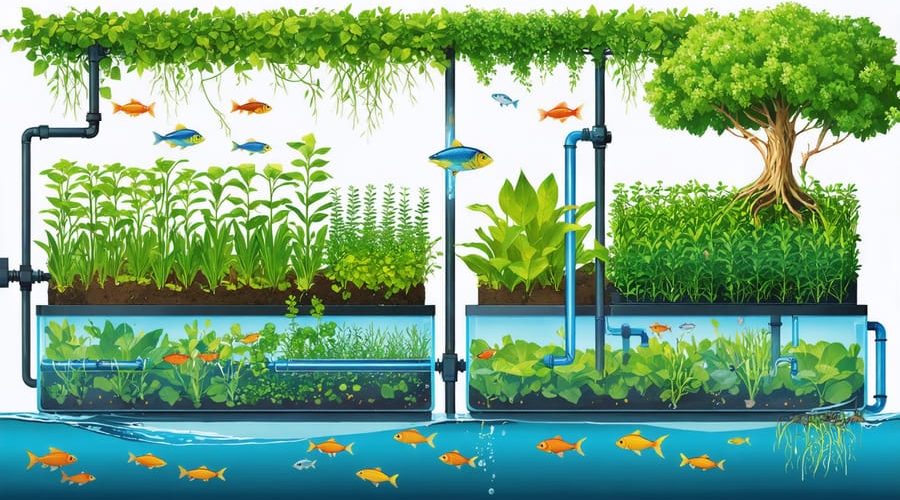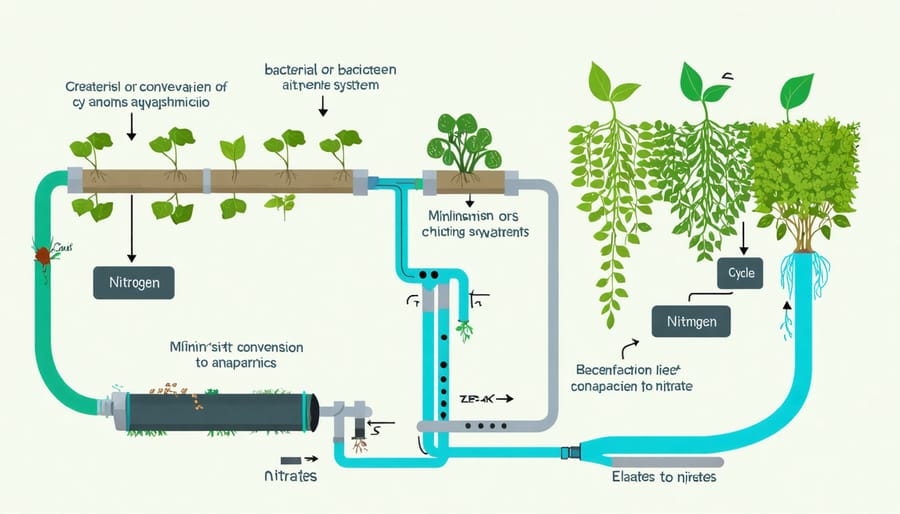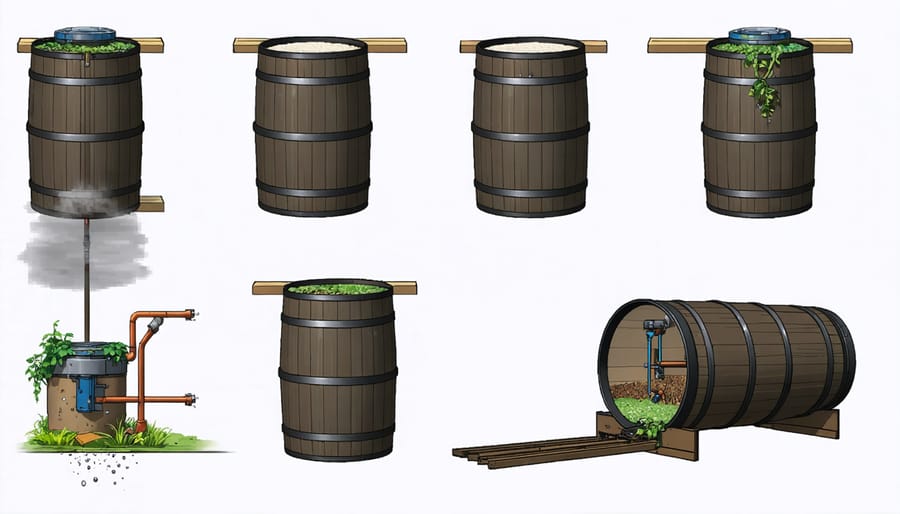
Make Your Aquaponics System Thrive: Simple Biofilter Secrets Revealed
Biofilters stand as the beating heart of every successful aquaponics system, transforming toxic fish waste into vital plant nutrients through a remarkable biological process. These essential components house beneficial bacteria that convert ammonia from fish waste into nitrates, creating the perfect symbiotic environment where both fish and plants thrive. Whether you’re building your first backyard aquaponics setup or optimizing an existing system, understanding biofilter dynamics unlocks the key to sustainable food production.
Recent advances in biofilter technology have revolutionized home aquaponics, making it possible to maintain larger fish populations in smaller spaces while ensuring optimal plant growth. From simple media beds filled with expanded clay pellets to sophisticated moving bed reactors, modern biofilters offer DIY enthusiasts powerful solutions for creating efficient, closed-loop ecosystems. This natural filtration approach not only maintains water quality but also reduces water consumption by up to 90% compared to traditional gardening methods.
By mastering biofilter principles, you’ll join a growing community of sustainable food producers who harness the power of natural biological processes to create abundant harvests while conserving precious resources. Let’s explore how these remarkable systems work and how you can implement them in your own aquaponics setup.
How Aquaponic Biofilters Keep Your System Clean
The Natural Cleaning Process
Nature has perfected a remarkable cleaning process that we harness in aquaponic biofilters. At the heart of this process is the nitrogen cycle, where beneficial bacteria work tirelessly to convert harmful waste into useful nutrients.
Think of it as nature’s recycling system: fish produce ammonia through their waste and breathing, which would normally be toxic in high concentrations. However, two types of bacteria come to the rescue. First, Nitrosomonas bacteria convert ammonia into nitrites. Then, Nitrobacter bacteria transform these nitrites into nitrates – a form of nitrogen that plants love.
This process happens continuously in your biofilter, creating a perfect balance between the fish and plants in your system. The bacteria colonize the filter media, forming a living cleanup crew that works 24/7. The best part? Once established, this natural process is self-sustaining, requiring minimal intervention from you.
Just remember that these helpful bacteria need time to establish themselves, usually taking about 4-6 weeks to form a strong colony. During this period, it’s crucial to be patient and monitor your water parameters regularly.

Why Your Plants and Fish Need Biofilters
In an aquaponics system, biofilters are the unsung heroes that keep both your fish and plants thriving. For your fish, these fantastic filters transform harmful ammonia from fish waste into safer nitrates through beneficial bacteria. Without this crucial process, ammonia levels would quickly become toxic to your aquatic friends.
Your plants, on the other hand, absolutely love the nitrates that biofilters produce. These nutrients are like a natural fertilizer, helping your plants grow bigger, stronger, and produce better yields. The best part? This whole process happens naturally, creating a perfect circle of life in your system.
But the benefits don’t stop there. Biofilters also help maintain stable water conditions by regulating pH levels and removing debris. This means clearer water for your fish and a more consistent environment for your plants’ roots. They even help oxygenate the water, which both fish and plant roots need to stay healthy.
Think of biofilters as nature’s cleanup crew, working 24/7 to keep your aquaponics system in perfect balance, ensuring both your aquatic and plant life can flourish together.
Choosing the Right Biofilter for Your Setup
Mechanical vs. Biological Filtration
When it comes to keeping your aquaponics system clean and healthy, you’ll need to understand two key filtration methods: mechanical and biological. Mechanical filtration is like a bouncer at a club – it catches and removes solid waste particles, uneaten food, and debris from your water. Think of it as the first line of defense, using materials like foam, filter pads, or screens to trap these physical particles before they can break down and cause problems.
Biological filtration, on the other hand, is more like having a team of tiny cleaning crews working 24/7. This process relies on beneficial bacteria that naturally convert harmful ammonia (from fish waste) into less toxic substances. These bacteria create colonies on special filter media, breaking down waste products into nutrients that your plants can actually use.
While both types of filtration are important, they work best when used together. Mechanical filtration helps protect and maintain your biological filter by preventing it from getting clogged with solid waste. Without mechanical filtration, your biological filter would quickly become overwhelmed. Meanwhile, biological filtration does the crucial job of processing dissolved waste that mechanical filtration can’t catch.
For most home aquaponics systems, a combination of both filtration types will give you the best results. Start with mechanical filtration to remove solids, then let the biological filter do its work on the dissolved waste.

Popular DIY Biofilter Options
Building your own biofilter doesn’t have to be complicated or expensive. Here are some popular DIY options that work great for a DIY aquaponics system.
The barrel biofilter is a favorite among hobbyists. Using a 55-gallon plastic drum, you can create an efficient filter by layering different media like bio-balls, lava rock, and filter mats. Simply drill holes for inlet and outlet pipes, add your media in layers, and you’re good to go!
Another popular choice is the IBC tote conversion. These large containers can be easily transformed into powerful biofilters by adding filter media and creating separate chambers for mechanical and biological filtration. The transparent sides make it easy to monitor water flow and maintenance needs.
For smaller systems, a bucket biofilter works wonders. Stack two 5-gallon buckets, with the top bucket containing filter media and holes drilled in the bottom. The lower bucket collects filtered water and houses the pump. This setup is perfect for beginners and can be assembled in under an hour.
Don’t forget about shower filter towers! Using PVC pipe filled with bio-media, these vertical filters are space-efficient and provide excellent surface area for beneficial bacteria. They’re especially useful when garden space is limited.
Each of these options can be customized to match your system’s specific needs and budget. Remember to include proper aeration and ensure easy access for maintenance.
Setting Up Your Biofilter: Step-by-Step

Installation Made Easy
Setting up your aquaponic biofilter doesn’t have to be complicated. Follow these straightforward steps to get your system up and running smoothly.
First, choose a suitable location near your aquaculture tank. You’ll want easy access for maintenance and a slight elevation to allow gravity-assisted water flow. Position your biofilter container – a food-grade barrel or purpose-built filter tank works great.
Create two zones in your filter: mechanical and biological. Start by installing a pre-filter at the water inlet to catch larger debris. Use filter mesh or a fine screen with approximately 200-300 micron openings. This prevents solid waste from clogging your biological media.
For the biological section, add your chosen filter media in layers. Start with larger pieces at the bottom (like bio-balls or lava rock) and progress to finer media toward the top. Leave about 6 inches of space at the top for water movement. Make sure to rinse all media thoroughly before use to remove any dust or debris.
Connect your pump system using appropriate PVC piping. Install valves to control water flow and make future maintenance easier. The ideal flow rate should cycle your entire tank volume through the filter at least once per hour.
Before adding fish, run your system for 2-3 weeks to establish beneficial bacteria. Add a small amount of ammonia source (like fish food) during this cycling period to jumpstart the bacterial colony.
Monitor water parameters regularly during the first month. Once readings stabilize, you’ll know your biofilter is functioning properly and ready for full operation.
Remember, a well-installed biofilter is the heart of your aquaponics system, so take your time to get it right!
Maintaining Your Biofilter
Regular maintenance is key to keeping your biofilter running efficiently. Start by establishing a weekly routine of checking flow rates and cleaning any visible debris from your filter media. Every two weeks, perform thorough water testing to monitor ammonia, nitrite, and nitrate levels – this helps you catch potential problems early.
Monthly maintenance should include gently rinsing your mechanical filtration components, but avoid using tap water as the chlorine can harm beneficial bacteria. Instead, use water from your system. Never clean all filter media at once; this preserves enough beneficial bacteria to maintain the nitrogen cycle.
Watch out for these common issues:
– Reduced water flow: Usually caused by clogged media or pump problems
– Strange odors: Could indicate anaerobic conditions requiring immediate attention
– Cloudy water: Often results from bacterial bloom or excess waste
– Unexpected pH changes: May signal it’s time to check your media condition
If you notice a decline in plant growth or fish health, check your biofilter first. Sometimes, simply backwashing the system or adjusting flow rates can solve the problem. During colder months, consider adding insulation around your biofilter to maintain bacterial activity.
Remember to replace about 10-20% of your filter media annually, as it naturally breaks down over time. When adding new media, introduce it gradually to allow beneficial bacteria to colonize without disrupting the system’s balance. Keep spare parts on hand, especially pump components and basic plumbing fittings, to handle emergency repairs quickly.
Common Biofilter Problems (And How to Fix Them)
Warning Signs to Watch For
Keeping a close eye on your biofilter’s performance can help you catch issues before they become serious problems. The most obvious sign of trouble is cloudy or discolored water, which often indicates that your pump and filter system isn’t working efficiently.
Watch for any unusual odors, particularly strong fishy or ammonia smells, which suggest your biofilter isn’t processing waste properly. If your fish are gasping at the surface or seem lethargic, this could mean oxygen levels are low due to poor filtration.
Keep an eye on your plant health too. Yellowing leaves or stunted growth might indicate that your biofilter isn’t converting enough nutrients for your plants to thrive. Regular water testing is essential – if you notice ammonia or nitrite levels rising, your beneficial bacteria might be struggling.
Check for any unusual buildup of algae or debris around your filter media. This could mean it’s time for cleaning or indicates poor water flow. Listen for any unusual sounds from your pump – grinding or gurgling noises might mean there’s a blockage or air in the system.
If water flow seems reduced, check for clogged pipes or media. Remember, catching these issues early can prevent bigger problems and keep your system running smoothly.
Quick Solutions for Better Performance
Here are some quick fixes that can instantly improve your biofilter’s performance. If you notice cloudy water, add more filter media to increase surface area for beneficial bacteria. For slow water flow, simply clean or unclog your mechanical filters and check for any pipe blockages. When ammonia levels spike, temporarily reduce fish feeding and add pre-cycled media from an established system to boost bacterial colonies.
Low oxygen issues? Try adding an air stone near your biofilter or creating more water movement with a small waterfall feature. If your biofilter seems overwhelmed, consider splitting the flow between two smaller units instead of one large one. This provides backup filtration and makes maintenance easier.
For temperature concerns, shield your biofilter from direct sunlight in summer and insulate it during winter. If you’re dealing with excessive nitrates, add more plants to your grow beds or incorporate floating rafts with fast-growing leafy greens.
Bad odors usually signal anaerobic conditions – increase aeration and remove any dead spots in your filter media. For optimal performance, rinse your mechanical filtration weekly but avoid cleaning biological media with tap water, as chlorine can harm beneficial bacteria. Remember, small adjustments often make a big difference in maintaining a healthy aquaponic ecosystem.
Each solution is simple to implement and can help restore balance to your system quickly.
Implementing a biofilter in your aquaponics system is one of the most rewarding steps you can take toward creating a thriving, sustainable ecosystem. As we’ve explored throughout this guide, biofilters are the unsung heroes that keep your water clean, your fish healthy, and your plants flourishing. They work tirelessly behind the scenes, transforming harmful waste into valuable nutrients through the amazing process of biological filtration.
Remember, whether you choose a simple DIY solution or a more advanced commercial unit, the key principles remain the same: provide ample surface area for beneficial bacteria, ensure good water flow, and maintain consistent conditions. Don’t be intimidated by the initial setup – start small and expand as you gain confidence. Many successful aquaponics enthusiasts began with basic systems that grew alongside their experience.
The benefits of a well-maintained biofilter extend far beyond just clean water. You’ll spend less time on system maintenance, save money on water changes, and create a more stable environment for your aquatic ecosystem. Plus, the satisfaction of watching your system thrive naturally is truly incomparable.
Ready to get started? Take the first step today by planning your biofilter setup. Remember, every successful aquaponics system started with someone just like you deciding to take that initial plunge. Your future self will thank you for making this investment in your system’s health and sustainability.
